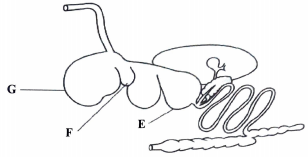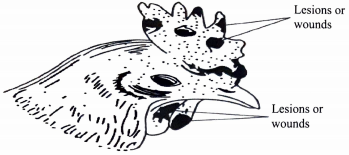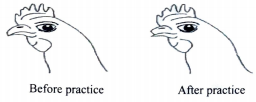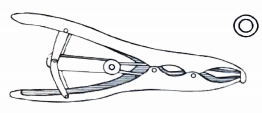Instructions to candidates
- This paper consists of three sections; A, B and C.
- Answer all the questions in sections A and B.
- Answer any two questions in section C.
SECTION A (30 marks)
Answer all the questions in this section.
- State two functions of walking area in a zero grazing unit. (1 mark)
- Give four characteristics of succulent roughages. (2 marks)
- State four symptoms of contagious abortion. (2 marks)
- State four factors considered when selecting eggs for marketing. (2 marks)
- State four maintenance practices that should be carried out on a hoof cutter. (2 marks)
- State four limitations of a tractor as a source of power on the farm. (2 marks)
- Name four beef cattle breeds. (2 marks)
- State the origin of each of the following dairy cattle breeds: (1 mark)
- Friesian
- Ayrshire
- State four control measures for foot rot. (2 marks)
- State four signs of heat in pigs. (2 marks)
- State two categories of livestock parasites. (1 mark)
- Name two types of calf pens used in cattle production. (1 mark)
- State four ways in which identification in livestock production is important. (2 marks)
- State four preventive measures for livestock diseases. (2 marks)
- State four reasons for castration in livestock production. (2 marks)
- Name four causes of livestock diseases. (2 marks)
- State four methods of fish preservation. (2 marks)
SECTION B (20 marks)
Answer all the questions in this section
- Below is an illustration of the digestive system of livestock.
- Name one livestock with the digestive system illustrated above. (1 mark)
- Name the part labelled:
- E ( 1 mark)
- F ( 1 mark)
- State two functions of the part labelled part G. (2 marks)
- Below is an illustration of a bird infected with a poultry disease.
-
- Identify the disease. (1 mark)
- Name another body part also affected by the lesions or wounds. (1 mark)
- State two predisposing factors of the disease. (2 marks)
- State one control measure of the disease. (1 mark)
-
- Below is an illustration of a practice carried out in poultry.
-
- Identify the practice. (1 mark)
- Give one reason why the use of a hot iron is recommended for the practice illustrated. (1 mark)
- Name two poultry vices controlled by the practice illustrated. (2 marks)
- State one feeding practice that helps to control these poultry vices. (1 mark)
-
- Below is a diagram of a tool used in livestock rearing.
- Identify the tool. (1 mark)
- State two uses of the tool. (2 marks)
- Give two reasons why farmers prefer using the tool. (2 marks)
SECTION C (40 marks)
Answer any two questions from this section
-
- Describe seven requirements of an ideal calf pen. (7 marks)
- State the disadvantages of natural mating in livestock breeding. (8 marks)
- Explain five predisposing factors of mastitis disease in dairy farming. (5 marks)
-
- Explain nine qualities of an ideal brooder for day old chicks. (9 marks)
- Describe the working mechanism of a four-stroke cycle engine. (11 marks)
-
- Explain five control measures for tapeworms. (5 marks)
- Give ten functions of equipment used in clean milk production. (10 marks)
- Describe the life cycle of a one-host tick. (5 marks)

Marking Scheme
SECTION A (30 marks)
- Functions of walking area (1 mark)
- Exercise
- For dunging
- sunning
(2 x ½mark)
- Characteristics of succulent roughages (2 marks)
- High fibre content
- High moisture content
- Low protein content
- High carbohydrate content
(4 x ½ mark)
- Symptoms of contagious abortion (2 marks)
- Low libido
- Spontaneous abortion/premature birth
- Barreness
- Retained afterbirths/placenta after abortion.
- Orchitis in bulls.
- Yellow brown slimy/odourless discharged from vulva after abortion
(4 x ½ mark)
- Factors considered in selecting eggs for marketing (2 marks)
- Cleanliness
- Size of egg
- Candling qualities (Accept specific candling qualities e.g freshness).
- Egg colour
- Shell texture
(4 x ½ mark)
- Maintenance practice of hoof cutter (2 marks)
- Repair broken parts e.g. handle.
- Oil the metal parts on long storage
- Sharpen jaws when blunt
- Clean after use
- Grease moving parts to reduce friction
- Tightening the nut
- proper storage.
(4 x ½mark)
- Disadvantages of a tractor as a source of power (2 marks)
- Expensive to buy and maintain
- Requires skilled personnel
- Their use is limited in certain areas i.e slopy areas.
- It requires support services O.W.T.T.E
- Expansive to maintain
(4 x ½mark)
- Beef breeds (2 marks)
- Hereford
- Galloway
- Aberdeen angus
- Beef shorthorns
- Charolais
(4 x ½ mark)
- Origin of breeds (1 mark)
- Friesian - Holland/Holstein/Denmark Accept Netherlands
- Ayrshire - Scotland
(2 x ½mark)
- Control measures of foot rot (2 marks)
- Clean environment/avoid dampness/muddy conditions
- Regular hoof trimming
- Regular walk through foot bath/copper II sulphate solution
- Treat wounds with antiseptics
- Isolate sick animals
(4 x ½ mark)
- Signs of heat in pigs (2 marks)
- Restlessness
- Frequent urination
- Swelling & reddening of the vulva
- Clear & slimy mucus discharge from the vulva
- Frequently mounting others
- Positive response to riding test
(4 x ½ mark)
- Categories of livestock parasites (1 mark)
- Internal parasites/endo-parasites
- External parasites/ecto-parasite
2 x ½ marks
- Types of calf pens (1 mark)
- Raised permanent pens/slated floors
- Permanent calf pen with concrete floors
- Movable/Mobile calf pens
2 x½ marks
- Importance of identification (2 marks)
- Selection/breeding
- Disease control/treatment
- Feeding
- Record keeping
- Culling
- For tracing purposes.
4 x ½ marks
- Preventive measures for livestock diseases (2 marks)
- Isolation of sick animals usual
- Imposition of quarantine
- Proper feeding
- Proper housing
- Use of prophylactic measures
- Proper hygiene
- Slaughter and proper disposal of infected animals
- Use of antiseptics/disinfectants.
- Proper selection and breeding.
- Treatment of sick animals.
To score - Control of vectors.
- Vaccination
- Deworming
- Prophylactic drugs
4 x½ marks
- Reasons of castration (2 marks)
- To control inbreeding
- Control breeding diseases
- Hasten growth rate
- Control breeding
- Increase quality of meat especially in goats
- To make the animal docile
4 x½ marks
- Causes of livestock diseases (2 marks)
- Bacteria
- Protozoa
- Parasites
- Virus
- Nutritional disorders
- Physical injuries
- fungi.
- Chemical causes
- Amount of food eaten
4x½ marks
- Methods of fish preservation (2 marks)
- Freezing
- Salting
- Sun drying
- Smoking
4x½ marks
SECTION B (20 marks)
-
- Cattle/sheep/goat (1 mark)
-
- E - Abomasum/True stomach (1 mark)
- F - Reticulum/Honey comb (1 mark)
- Functions of rumen(G) (2 marks)
- Temporary storage of food before regurgitation
- Fermentation of food
- Microbial digestion
- Synthesis of vitamin B complex
- Synthesis of Amino acids
- Breakdown of protein to peptides
- Breakdown of carbohydrates and cellulose to carbon(iv)oxide and volatile fatty acids
- Absorption of ammonia gas & fatty acids
2x1
-
-
- Fowl pox (1 mark)
- Legs/vent/wings (1 mark)
- Predisposing factors of fowl pox (2 marks)
- Presence of wounds
- Presence of biting insects e.g. mosquitoes/mites
2x1
-
- Vaccination (1 marks)
- Killing and proper disposal of all infected birds
1x1
-
-
-
- Debeaking (1 mark)
- It cauterizes the wound Prevent bleeding/Prevent infection/Sterilize the wound 1 mark
-
- Cannibalism 2 marks
- Egg eating
2 x 1
-
- Provide adequate balanced diet (1 mark)
- hanging vegetables in the poultry house/ by scattering grains on the land
1 x 1
-
-
-
- Elastrator (1 mark)
- Rubber ring
1 x 1
-
- Docking (2 marks)
- castration
- dis-budding
2 x 1
-
- bloodless (2 marks)
- Less painful
- Less stressful
- less skills required
2 x 1
-
SECTION C (40 marks)
-
- Requirements of ideal calf pen (7 marks)
- Ensure its-pens should have concrete floors to facilitate cleaning
- Make dry and warm- dry litter should be placed on the floor to avoid dampness/wetness.
- Roof should not leak/avoid spilling water on the floor to discourage dampness and wetness of the litter
- Adequate space: Should be spacious for exercise, feeding and watering of calves.
- Proper lighting - should be well lit as light is necessary for synthesis of vitamin D.
- Proper drainage - should be constructed on a well-drained place to avoid dampness
- Draught free - to prevent entry of cold winds and discourage infections like pneumonia
- Proper ventilation - to allow free air circulation
- Single housing - calves should be housed singly to prevent licking one another which can lead to formation of hair - balls in the rumen
7 x 1
- Disadvantages of natural mating (8 marks)
- High chances of inbreeding
- Possible to transmit sexual diseases
- Males need extra costs of feeding and rearing
- Large males can injure small females
- A lot of semen is wasted
- Difficult and expensive to transport a bull over long distances to serve a cow
- Bulls are expensive to acquire
- Most bulls are aggressive hence difficult to handle
8x1
- Pre-disposing factors (5 marks)
- Age
- old animals are likely to be infected than young ones.
- Stage of lactation
- animals are likely to suffer at the beginning and at the end of lactation
- Udder attachment
- animals with large pendulus loosely hanging udder and long teats are more susceptible to mastitis
- Incomplete milking
- When milk left in teat canal it acts as culture medium for bacteria
- Mechanical injuries
- wounds on teats/udder allow micro-organism entry into the udder.
- Poor sanitation,
- increases multiplication of the bacteria causing mastitis
- Poor milking techniques
- may result in mechanical injury of the teats, sphinster muscles of the teats
(5 × 1
- may result in mechanical injury of the teats, sphinster muscles of the teats
- Age
- Requirements of ideal calf pen (7 marks)
- Requirements of ideal brooder (9 marks)
- Litter: should be inform of wood shavings to maintain warmth and absorb moisture
- Fresh air/ventilation: should have holes for ventilation on the walls to allow proper gaseous exchange
- Heat source - a heat source be provided and controlled to maintain correct temperature within the broader.
- Well lit – to allow chicks to see feeds and water.
- Dim light is recommended as bright light blinds the chicks and enhances toe pecking
- Have adequate waterers; and feeders; to allow for proper feeding and watering of chicks without overcrowding
- Shape of the brooder : should be round in shape to avoid chicks overcrowding at the corners
- Fresh feed and water:
- Some feeds should be put on newspapers on the floor until chicks learn to feed from the feeders
- Have adequate feeders- to allow for proper feeding without overcrowding
9x1
- Operation of a four stroke cycle engine (11 marks)
- Induction stroke; the piston moves down the cylinder; inlet valve opens; fresh air and petrol is drawn into the cylinder;Exhaust valve closed.
- Compression stroke; the inlet valve closes, outlet valve closes; the piston up moves up the cylinder; this compresses: air fuel mixture in the combustion chamber;
- Power stroke; a spark produced by the spark plug; this causes compressed fuel mixture to light and expand; resulting in pressure that forces piston down the cylinder; .
- Exhaust stroke: piston moves up the cylinder, eliminating burnt fuel mixture through open exhaust valve;
11x1
- Requirements of ideal brooder (9 marks)
-
- Control measures of tapeworms (5 marks)
- Use of anthelmintic drugs/prophylactic drugs
- Keep animal house clean and disinfected
- Rotational grazing
- Keep feeders and waters clean
- Proper disposal of human excreta
- Proper inspection of meat
- Proper cooking of meat
- Ploughing of infested pastures
- Burning of infected pastures
5 x 1
- Milking equipment (10 marks)
- udder cloths and towels for cleaning/drying the udder
- filtering pads for straining milk
- milking jelly for applying on teats to prevent cracking
- warm water for washing the udder
- milking pail/bucket for milk/holding with during milking.
- milking churn for holding milk in storage or transportation
- milking stool to sit on during milking
- weighing scale for weighing milk
- cooler/fridge for cooling milk
- strip cup for checking mastitis
- milking machine for machine milking
- rope/chain for retraining the cow
10 x1
- Life cycle of a one host tick (5 marks)
- Eggs hatch larvae which climb onto the host and feed on blood;
- Engorged larvae moult, nymphs emerge, feed on blood;
- Engorged nymphs moult, adults emerge;
- Adults feed on blood and mate;
- Engorged female falls to ground and lays eggs;
5x1
- Control measures of tapeworms (5 marks)
Download Agriculture Paper 2 Questions and Answers - KCSE 2020 past papers.
Tap Here to Download for 50/-
Get on WhatsApp for 50/-
Why download?
- ✔ To read offline at any time.
- ✔ To Print at your convenience
- ✔ Share Easily with Friends / Students





